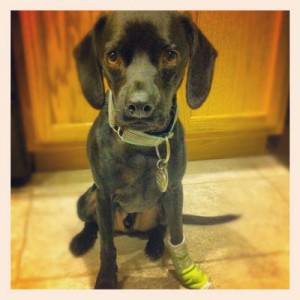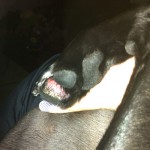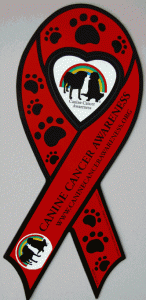
The bandaged foot, kept clean and dry.
Barret had spent the evening on my lap, as usual, but I noticed after a bit that he was chewing on one of his paws. I got up to examine it and was shocked to find a red, raw, inflamed toe. Just one toe, and it had to be twice the size of the rest of his toes. It looked painful!
I examined his paw for the source of the discomfort, a cut or scratch, maybe a burr or stone, even a bug bite, but could not find anything. He didn’t seem like he was in pain and was perfectly content to lick on his Lickety Stick while I soaked his foot in warm soapy water and bandaged it up. In every other way he seemed completely normal. I made the decision to keep an eye on it and treat it at home.

Bear’s offending paw. Looks painful!
The next night, he was relaxing on his back while I gave a well-deserved belly rub when I noticed a large lump had formed in his armpit (on the same leg as the swollen toe). Why is it that we find these things after regular vet hours? I hopped on the internet and did some searching. There wasn’t much to go on but I had myself convinced it was a lymph node swollen because of the infection in his toe. The next morning I made an appointment with my regular vet and was fully convinced that I’d leave with a course of antibiotics and instructions to keep the toe clean.
I’m very glad I consulted with my vet, because on further examination my assumption was wrong. The toe was infected, though it was a more severe infection that I had originally thought. It required 2 full courses of antibiotics before it cleared up. The lump on his armpit is another matter entirely. The doc’s conclusion was that it is a cyst with a clearly defined blood supply, but should cause him no problems and doesn’t need to be removed unless it starts to get in his way. Phew!
The moral of the story is that you should always consult your veterinarian rather than making guesses at home. Your kids’ health is at stake! If I hadn’t sought care for Barret’s foot, the infection could have spread and required IV antibiotics or more drastic measures.

Back from the vet with a clean bill of health
Dogs often have lumps and growths all over their bodies and as pet parent’s it is our duty to examine and find these anomalies early, before they get out of hand. Many lumps and bumps, like Bear’s cyst, are benign and nothing to worry about, but a similar lump might actually be cancerous and require treatment. The earlier you find and treat a problem, the easier it is to manage.
Watch for a future article where I’ll go over a step by step home physical so that we can track the changes in our pets bodies and know when to schedule an appointment with the vet. In the meantime, please share your stories of lumps or bumps that turned out to be nothing or turned out to be problematic. We can learn from each other’s experiences.
-Heather
 1 in every 4 dogs and 1 in every 5 cats will develop cancer in their lifetimes. That is a sobering number of pets diagnosed each year. November is National Pet Cancer Awareness Month, and as a pet parent of a dog who has beat cancer, I’m here to tell you that cancer isn’t a death sentence.
1 in every 4 dogs and 1 in every 5 cats will develop cancer in their lifetimes. That is a sobering number of pets diagnosed each year. November is National Pet Cancer Awareness Month, and as a pet parent of a dog who has beat cancer, I’m here to tell you that cancer isn’t a death sentence. That Pet Blog That Pet Place Pet Blog
That Pet Blog That Pet Place Pet Blog




 Hi fellow pet lovers,
Hi fellow pet lovers,



